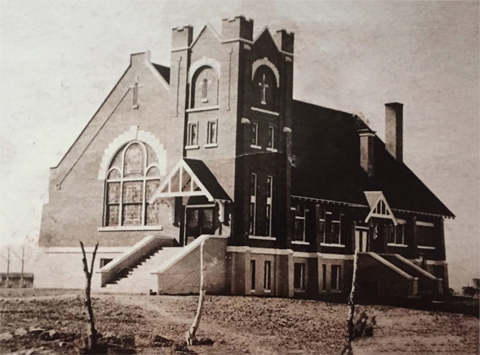(Picture of Charles Hartley)
Charles Hartley was born on 29 September 1817, Wakefield, Yorkshire, England. According to the records that are available, there were many Hartleys settled in this part of the country. Little is known of Charles Hartley’s early life. He was a stonemason by trade and worked at Liverpool. It was in Liverpool that he and his young wife, Eliza Horne, first heard the gospel of Jesus Christ of Latter-day Saints. He was baptized by Joseph Hall at Tadcaster, Yorkshire, on 18 April 1843 and confirmed on the same day by Elder Cuerdon from Bradford, England.
Charles and his young wife made the decision to emigrate to America. The following is taken from the report of Richard Ballenstine, part of the First Permanent Emigration Fund and from the Deseret News of 25 April 1883:
He emigrated for America, leaving Liverpool, Wednesday, January 17, 1855, on the clipper ship Charles Buck. There were 400 passengers aboard. Among those were seventy Scandinavian converts. In charge was Elder H.M. Hogan and the remainder were British saints who had been re-shipped from the ship Heloris, in the charge of Richard Ballentine. The English part of the company shippers on the Heloris were well provided for by President F. D. Richards but when the transfer was made to the Charles Buck they were not allowed to take their supplies with them. They were furnished with very poor rations, consisting mainly of raw oatmeal, coarse brown bread, rice and flour. Even at this the supply was very short. The health of the passengers was very bad and except for the blessings from anointings and administrations, there would have been much more hardship.
During the voyage the saints made 21 tents and 20 wagon covers. They arrived at New Orleans on March 14, 1855 and embarked on the steamer Michigan, March 17, 1855 for St. Louis, Missouri. They arrived on March 27, 1855. From St. Louis they went by boat to Achison where they were outfitted with 24 wagons, 220 oxen, 24 cows, 3 horses and 1 mule, all provided by the Permanent Emigration Fund. They left Achison July 1, 1855.
The Hartleys that were in the company were Charles, his wife Eliza, his children Hyrum, Eliza, Charles R. and Samuel J. (who died at sea).
Others of Charles Hartley’s family who emigrated for the Gospel were his sister, Hannah and his brother, Samuel. Samuel later went to California and left the Church because he thought the polygamists were eyeing his beautiful wife.
Settling first in Salt Lake, Charles worked as a stonemason on the Salt Lake Temple. They arrived in Salt Lake with nothing and were extremely poor, having to make contributions to the Permanent Emigration Fund to pay back their own transportation over to America and trying at the same time to make a living for themselves. Charles and his boys spent many hours working on the Temple. He had a great admiration for President Young and loved to tell how the great man ordered the best cuts of meat to give to the workers on the temple while he and others ate the soup bones and poorer cuts.
While Salt Lake was celebrating its tenth anniversary, word came that Johnson’s army was on its way to Salt Lake. The army was formed by U.S. President Buchanan because of false reports and lies of Mormon brutality and mutiny against the country. The Council of the Twelve heard the report with grave concern. Twice in Missouri and once in Illinois they had been driven from their homes. They were naturally aroused. Conquered they would not be even if they were driven out, they should leave behind them the land as they had found it.
The women and children with enough men to protect them were sent south for safety. Guards were left to fire the property should the army come.
Charles Hartley was ordered to go with those who were evacuating. He had an old decrepit horse and a mule hitched to a wagon and his few meager possessions piled on them. President Young, amused but touched at the sight said, “Brother Hartley, there will never be a team pass you!” and there wasn’t.
The company went south to Spanish Fork. Being a stonecutter by trade, Charles was put to work building ovens for the camp. When the danger was over and the army had gone, many returned to Salt Lake, but a great many were called to settle communities nearby. Charles tried to farm at Tooele County, Utah, but this was unsuccessful. He moved to Ogden where he worked as a stonemason on many of the buildings that were going up. He worked diligently in the Church conducting the Ogden choir. Then he was called to go to the North Weber Stake to live the United Order. This experience was a failure as they all were, because of the frailties of human nature. Charles was discouraged and a little disillusioned.
He moved to Bountiful with his family. His health by this time was failing. His occupation was an unhealthy one and he suffered from what they called stonecutter’s consumption.
He worked at odd jobs while his older boys John and James went to Strawberry to do ranch work. They later moved up into Idaho. One time as Charles was hauling timber from the mountains, he just about froze to death, but his little boy, Hyrum, rubbed him and made him walk until he recovered.
He lived in Bountiful until he died, on 15 April 1883. His life was full of service in the church. He was always willing to give of his talents, his time, and his means for the building up of the Kingdom of God. He has left a wonderful heritage for his posterity.
